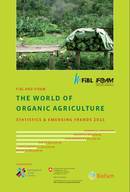Willer, Helga and Kilcher, Lukas (Eds.) (2011) The World of Organic Agriculture - Statistics and Emerging Trends 2011. IFOAM, Bonn and FiBL, Frick.
Preview |
PDF
- English
(The World of Organic Agriculture 2011)
5MB |
![[thumbnail of cover-willer-kilcher-2011.jpg]](/19310/4.hassmallThumbnailVersion/cover-willer-kilcher-2011.jpg)  Preview |
Image (JPEG)
- Cover Image
- English
4kB |
Summary in the original language of the document
Organic agricultural land and farms as well as the global market continued to grow during 2009 as documented in the 2011 edition of "The World of Organic Agriculture".
Organic land and producers
According to the latest FiBL/IFOAM survey on certified organic agriculture worldwide (data as of end of 2009, statistical information on organic agriculture is now available from 160 countries, an increase of six countries since the 2010 survey (data 2008).
There are 37.2 million hectares of organic agricultural land (including in-conversion areas). The regions with the largest areas of organic agricultural land are Oceania (12.2 million hectares), Europe (9.3 million hectares), and Latin America (8.6 million hectares). The countries with the most organic agricultural land are Australia, Argentina, and the United States.
Currently 0.9 percent of the world’s agricultural land is organic. However, some countries reach far higher shares: Falkland Islands (35.7 percent), Liechtenstein (26.9 percent), and Austria (18.5 percent). Seven countries have more than ten percent organic land.
Compared with the previous survey, organic land increased by two million hectares or six percent. Growth was strongest in Europe, where the area increased by almost one million hectares. The countries with the largest increases were Argentina, Turkey, and Spain.
Apart from agricultural land, there are further organic areas, most of these being areas for wild collection. These areas constitute 41.9 million hectares and have increased by 10 million hectares since 2008.
There were 1.8 million producers in 2009, an increase of 31 percent since 2008, mainly due to a large increase in India. Forty percent of the world’s organic producers are in Asia, followed by Africa (28 percent), and Latin America (16 percent). The countries with the most producers are India (677’257), Uganda (187’893), and Mexico (128’862).
Almost two-thirds of the organic agricultural land of 37.2 million hectares in 2009 was grassland/grazing areas (23 million hectares). With a total of at least 5.5 million hectares, arable land constitutes 15 percent of the organic agricultural land. An increase of 13.2 percent compared with 2008 was reported. Most of this category of land is used for cereals including rice (2.5 million hectares), followed by green fodder from arable land (1.8 million hectares), and vegetables (0.22 million hectares). Permanent crops account for approximately six percent of the organic agricultural land, amounting to 2.4 million hectares. Compared with the previous survey, almost half a million hectares more were reported. The most important crops are coffee (with 0.54 million hectares reported, constituting one-fifth of the organic permanent cropland), followed by olives (0.49 million hectares), cocoa (0.26 million hectares), nuts (0.2 million hectares), and grapes (0.19 million hectares).
Global market
According to Organic Monitor, the global market for organic food and drink is recovering from the repercussions of the economic crisis. Single-digit market growth was observed for the first time in 2009 because of the economic slowdown reducing industry investment and consumer spending power. Organic food and drink sales expanded by roughly five percent to 54.9 billion US dollars in 2009. Global revenues have increased over three-fold from 18 billion US dollars in 2000 and double-digit growth rates were observed each year, except in 2009. Healthy growth rates are envisaged to restart as consumer spending power rises and as more countries come out of economic recession. The countries with the largest markets are the US, Germany, and France; the highest per capita consumption is Denmark, Switzerland, and Austria.
-----------------------------------------
Book info
The World of Organic Agriculture - Statistics and Emerging Trends 2011 documents recent developments in global organic agriculture.
The World of Organic Agriculture 2011 includes contributions from representatives of the organic sector from throughout the world and provides comprehensive organic farming statistics that cover surface area under organic management, numbers of farms and specific information about land use in organic systems. The book also contains information on the global market for organic food, the latest developments in organic certification, standards and regulations and insights into current status and emerging trends for organic agriculture by geographical region (table of contents).
The World of Organic Agriculture is edited by the Research Institute of Organic Agriculture (FiBL) in cooperation with the International Federation of Organic Agriculture Movements (IFOAM).
The project is financially supported by the International Trade Centre (ITC), the Swiss State Secretariat for Economic Affairs (SECO) and Nürnberg Messe, the organisers of the BioFach World Organic Trade Fair.
| EPrint Type: | Book |
|---|---|
| Part or Full Programme: | Part of programme/Cluster of projects |
| Keywords: | Statistics, organic farming world-wide, land use, Africa, Asia, Europe, North America, Latin America, Australia & Oceania |
| Agrovoc keywords: | Language Value URI English statistical data http://aims.fao.org/aos/agrovoc/c_35655 |
| Subjects: | "Organics" in general > Countries and regions > World |
| Research affiliation: | Switzerland > FiBL - Research Institute of Organic Agriculture Switzerland > Society > Data & digitalisation > Statistics Switzerland > FiBL - Research Institute of Organic Agriculture Switzerland > Knowledge exchange > Publications International Organizations > International Federation of Organic Agriculture Movements IFOAM |
| Related Links: | http://www.organic-world.net, http://www.organic-world.net/yearbook-2011.html, https://www.fibl-shop.org/english/shop/show.php?sprache=EN&art=1546 |
| Deposited By: | Forschungsinstitut für biologischen Landbau, FiBL |
| ID Code: | 19310 |
| Deposited On: | 23 Aug 2011 13:42 |
| Last Modified: | 09 Nov 2021 10:16 |
| Document Language: | English |
| Status: | Published |
| Refereed: | Not peer-reviewed |
| Additional Publishing Information: | The book can be ordered from IFOAM at www.ifoam.org and the FiBL shop at https://www.fibl.org/shop |
Repository Staff Only: item control page

 Download Statistics
Download Statistics Download Statistics
Download Statistics
